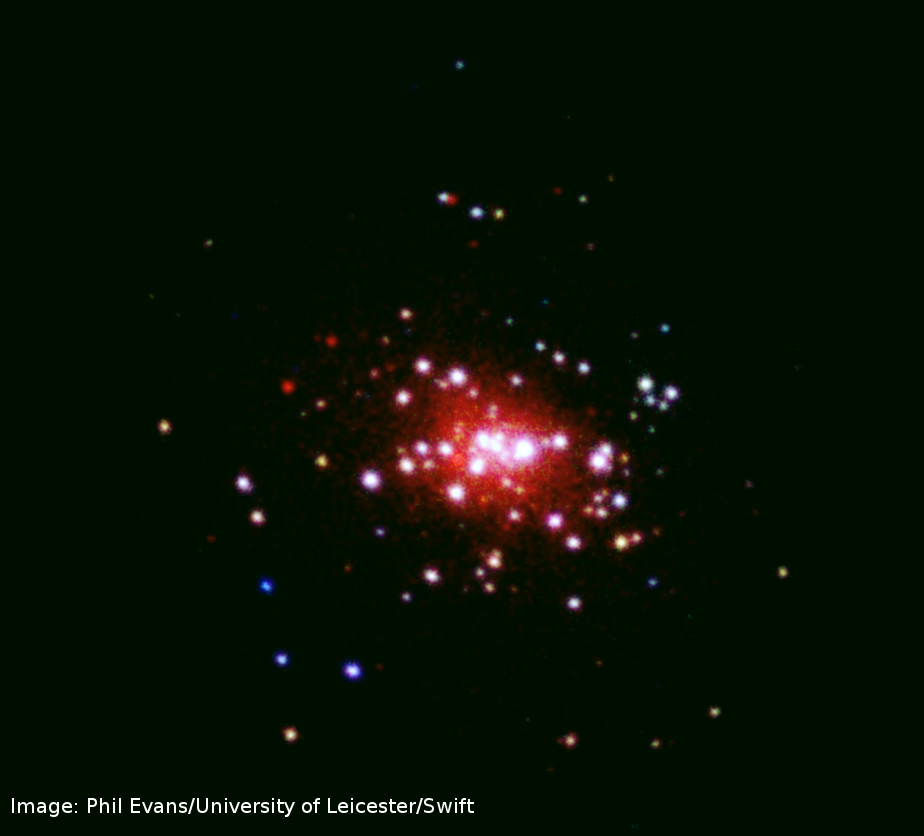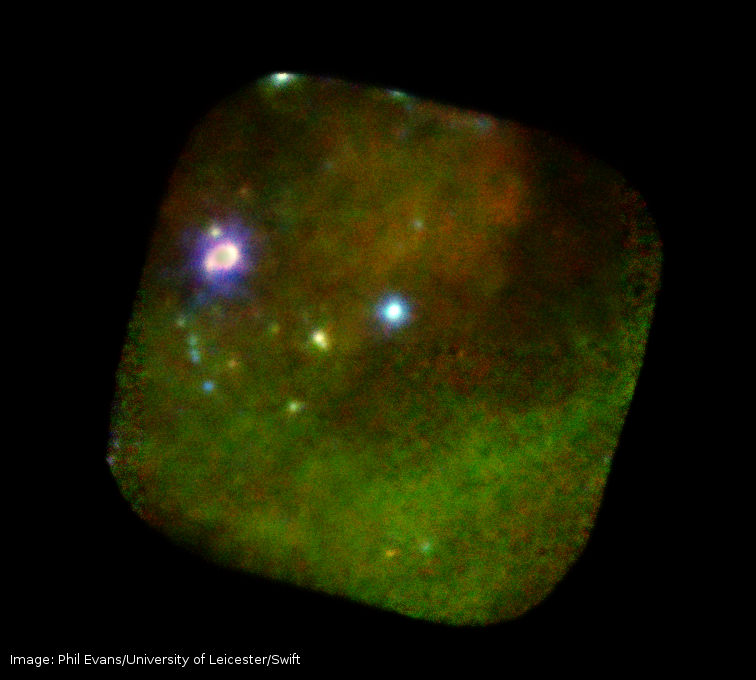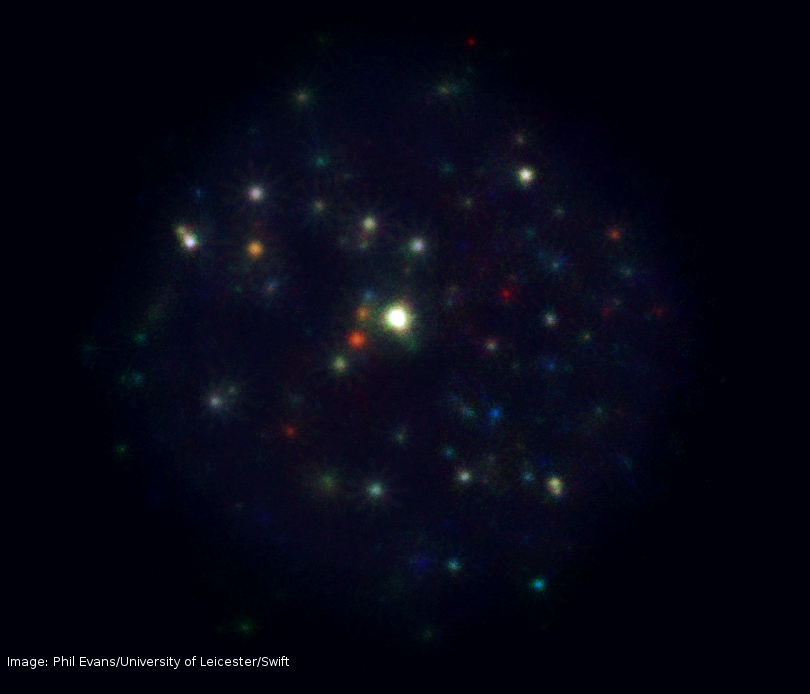Swift-XRT X-ray images
To help with a project for a student in the department this week, I made a few colour images of observations taken with the Swift-XRT; and I thought you may like to see them.
A brief explanation of what the colours mean is given after the images.
These images were all taken with the X-ray Telescope on board the NASA/UK/Italian Swift satellite. You can click on the images for bigger version. One pixel in the image corresponds to 1 pixel in the X-ray camera, and is 2.357 arcsecond to a side.
M31 - the Andromeda Galaxy
The nearest spiral galaxy to the Milky Way, and a spectacular sight through small telescope, M31, or the Andromeda Galaxy is well known to amateur astronomers, and is the most distant object visible to the naked eye (well, apart from GRB 080319B). It also hosts a wealth of X-ray emitting stars, as seen here, as well as a region of diffuse emission of soft X-rays (the red ones) towards the center.
This image is made of 700,000 s of exposure time.
WR25/Eta Carina/The Carina Nebula
The Carina nebula is a vast cloud of gas about 7,500 light years from Earth. The red and green swirls in this image are X-rays being emitted in this cloud. This is a busy part of the Galaxy, containing several very young star clusters. It is also home to the famous star Eta Carinae a massive star which is being closely monitored in the expectation that it could go supernova soon (NB. “soon” to astronomers is still potentially millions of years, so while it could go off next Wednesday, it may still be there when I die. [Not planned for next Wednesday!]). Eta Carinae is the bright blue-white object at the left hand side of this image. The bright object towards the centre of the image is star called WR25, the target of the Swift observations. WR25 is a Wolf-Rayet star. These are stars that started out life about 20 times as massive as the Sun, but in the Wolf-Rayet phase of life they shed mass at rates of maybe 0.00001 solar masses per year — that's about 3 Earth masses! Wolf-Rayet stars are widely believed to end their lives as supernovae or (in the right conditions) Gamma Ray Bursts.
This image is made of 240,000 s of exposure time.
GRB 060729
This wouldn't be a proper Swift gallery without a Gamma Ray Burst The bright object in the centre is GRB 060729: a Gamma Ray Burst caused by the explosive death of a massive star (probably a Wolf-Rayet star, discussed above), as its core collapsed to form a black hole. GRB 060729 was a very bright GRB, and at ‘only’4 billion light years away, is one of the more nearby GRBs we have detected. It is also one of the best studied objects. Most GRBs undergo a period where the X-ray brightness remains constant for a couple of hours, but in GRB 060729 this period went on for almost a day (see the X-ray light curve) and the GRB remained detectable by Swift for more than 100 days. Although there are a few GRBs which Swift observed until longer after the initial burst than GRB 060729, it looked at this object so often that it remains the GRB with the most exposure time by the Swift X-ray telescope, a whopping 1.2 million seconds (that's 13.8 days) of observations were carried out over a period of 151 days. This reveals a number of X-ray emitting objects in the region. Most of these are probably Active Galactic Nucleii (AGN). These are galaxies with a supermassive black hole — with masses around 100 million times that of the sun — at the centre. Material near the centre of an AGN falls into the black hole, and X-rays are given off in the process. The different colours of the objects show that some are hotter than others, or have more absorbing gas around them.
This image is made of 1,200,000 s of exposure time.
What do the colours mean?
These are ‘false colour’ in the sense that the X-rays were, well, X-rays; not red, orange, yellow etc (i.e. optical light). But X-rays still have colour. What our eyes & brains interpret as different colours in optical light, are really different frequencies of light. Red light is made of waves which oscillate comparitively slowly, a mere 400 thousand billion (i.e. 4×1014) times per second (this is the light's frequency, measured in Hertz, or Hz). Blue light has a higher frequency: it oscillates much more quickly, about 750 thousand billion times per second . And all the colours in between (the ones Richard of York battled vainly for) are made of light width frequencies between those of the red and blue light. X-rays oscillate much more rapidly. The X-ray telescope on Swift detects light with frequencies roughly 7×1016 Hz up to 2.5×1018 Hz (that is about 70 million billion Hertz up to 2.5 billion billion Hertz). So, to make these images we simply colour the low-frequency X-rays as being red (i.e. low frequency optical light), the medium frequency X-rays as green, and the high frequency ones as blue. Since these are the primary colours of light, this gives us X-ray images with the whole visible spectrum available, and the colours ‘mean’ the same as optical colours do when you look at something.


